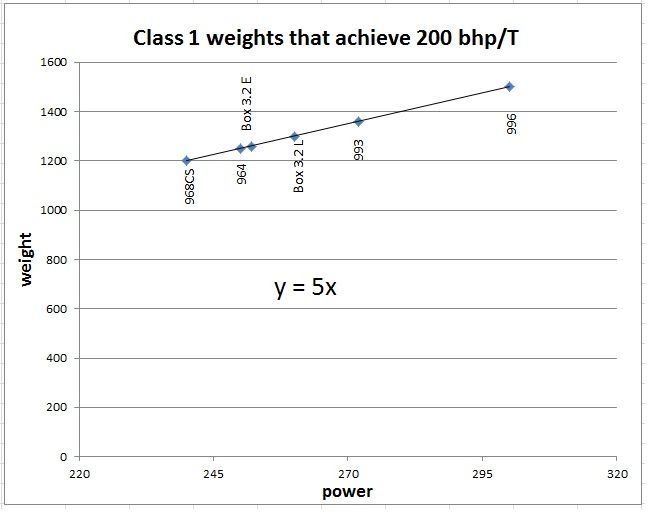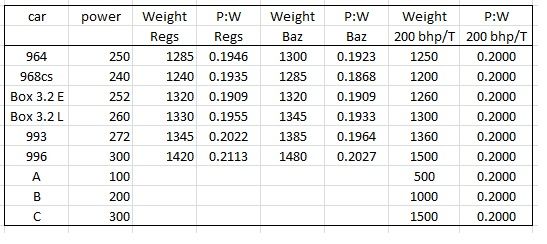You should upgrade or use an alternative browser.
The 2012 PCGB Club Championship
- Thread starter paulf968
- Start date
lali
New member




paulf968
New member
Steve Brookes
Moderator
Speaking as a scientist, in my world (biology, ecology and geology) a variability of 5% is an indeed an acceptable limit when making comparisons. Engineers and physicists work to much lower tolerances so might want a closer match. However, since racing involves a human element I'd say it's more akin to the touchy feely sciences. So in short...5% sounds a good aim to me. [ORIGINAL: paulf968 Permit me a comment to conclude. It is my opinion that these ranges of percentage differences are far too wide to enable balanced competition within each class. This is not a scientific suggestion but it does seem to me that the range covering all models should be smaller, certainly never bigger than 5% and any cars of similar power should not vary by more than say 1 or 2% from each other. Is this an idea that may have some merit?
Baz, I suspect you may have touched a nerve by exposing the frailties of the current system in public. In my experience(non motorsport in my case) the powers that be won't like it and will be determined to keep things as they are, no matter how right you are!ORIGINAL: bazhart I am surprised to have received so little support from other competitors. I am not sure if this is because they are not bothered, scared or don't understand it all. I hope (whatever the reason is) that my efforts to explain help them understand, my willingness to speak out provides them with some backbone and they realise that it is in the long term interests of the club to improve the methodology of power to weight ratio selection and the Motorsport division's response to communications to them from its members.... Come on Motorsport division take a few hours out to put it right, deliver the regs for next season and get your internal administration up to date and in touch with its members. Baz

Neil Haughey
New member
That is a very fair point Baz, and its the way I prefer to think about it. Fundamentally it was never explained. This is the point I made earlier and its something I find difficult because as soon as one starts to think of reasons why a particular car is set at a certain weight another example can be brought out as a counter point. Some simple examples: 1) Lets say for example that the 993 was given weight reductions because experienced showed they burned up the rear tyres and generally end up pretty tail happy. OK then why was the 996 introduced with a much bigger % advantage, was it assumed the engines just don't make the power like the old air cooled units etc. etc. this has never been clear to me. 2) Lets say in class 2 for next year the 3.2 Carrera has a big PWR advantage because its much more difficult to drive. Well what about the SC, couldn't any same logic be applied to that car which by the numbers looks like a poor option in class 2. I have said it before on here, after my last spin last year I followed Tim round for the last lap, his SC was no quicker down any of the straights than my S2 which means in reality he was never going to get enough cornering and stopping performance out of that car to beat well driven S2s. He knew that so its no surprise he didn't turn out this year. There is something none of us have pointed out till now. The regulations provision for any competitor to have to run with a data logger, most guys now run one of the two companies logging systems regularly anyway. It is interesting that competitors data recordings have not been asked for but I can understand that no one involved would have thought to ask in this situation. Looking at the actual traces for the cars concerned would settle this pretty clearly without any need for recourse to anything else. I will suggest to Steve when I talk to him to consider going down this route in the future which they already have provision for in the regs. It may have been put there as a mechanism to put off cheating but why on earth not use it to monitor if the weightings are appropriate? The actual data traces more than anything else will allow close comparison, its what professional race teams use and more and more its what many club competitors are using. If one driver is slow to the throttle but has a data channel for the throttle it will show, likewise if Baz's boxsters show higher speed corner traces but are still much slower over a lap it becomes un-debatable at that point, there is nothing left to prove or demonstrate only conjecture. I have been around Porsches for 13 years now, love my race car to bits and want to race it in my own car club.ORIGINAL: bazhart The actual precise figures or what you compare them with is not important - what is important is that if in a sequence of figures you are comparing - one sticks out much more than the others and however those things perform the performance of that one is also quite different to the others - you can be sure that it needs investigating and something is probably wrong.
StuartR16
New member
Neil Haughey
New member
If that was a certain orange and white car when he caught me last year ISTR I let him make an easy pass into Copse and was then held up all the way through Maggots/Beckets into Chapel. Once out on to the Hanger straight though he disappeared down the road like I was standing still. Surprised me a lot as I would have thought the 993 handles better than that but it is definitely amazingly quick out of corners and down the straights. I was doing 2:40 at the time and again ISTR he was several seconds a lap faster all from straight line performance I feel. As you say the 996 is a very different beast though quite apart from lap times it must have been pretty obvious to anyone either track side or on track that those things if setup properly corner like their on rails. Apart from anything to do with the 996 or 968 I will suggest to Steve putting the early 2.7 boxster in class 2, just can't see anyone building one to run in class 1 but with its extra grunt over the 2.5 it would definitely be competitive in class 2. I predicted who would win the championship right from the start based on the regs and entries, next year I predict that if someone who is experienced in 911's decides to enter a Carrera 3.2 in class 2 they will clear up and win the championship, take your pick from any number of experienced 911 racers that could do it. If I was one of them the temptation to get "your chance" at winning a prestigious championship would be too great not to look at. This is an even bigger problem than anything going on in class 1 as the situation with class 2 has yet again provided a championship winner from the lower division. I can't imagine anyone spending the big money competing in class 1 could be happy with that and besides your issue with the 996 Baz you guys competed pretty well in what ended up being a fairly close class 1 battle.ORIGINAL: bazhart As one leading 993 competitor stated - his car was slower in braking and cornering than our Boxsters but could always out drag them once well out of the corner. You know yourself that if you get stuck behind a driver that is slightly slower than you but in a roughly equal car - it can be almost impossible to get passed them because they hold you up in the corners and getting on the power and are just as quick down the straights. If the car in front is quicker on the straight it simple pulls away and you can never make it up even if your brakes are better. Baz
Steve Brookes
Moderator





Neil Haughey
New member

Posts made and opinions expressed are those of the individual forum members
Use of the Forum is subject to the Terms and Conditions
Disclaimer
The opinions expressed on this site are not necessarily those of the Club, who shall have no liability in respect of them or the accuracy of the content. The Club assumes no responsibility for any effects arising from errors or omissions.
Porsche Club Great Britain gives no warranties, guarantees or assurances and makes no representations or recommendations regarding any goods or services advertised on this site. It is the responsibility of visitors to satisfy themselves that goods and/or services supplied by any advertiser are bona fide and in no instance can the Porsche Club Great Britain be held responsible.
When responding to advertisements please ensure that you satisfy yourself of any applicable call charges on numbers not prefixed by usual "landline" STD Codes. Information can be obtained from the operator or the white pages. Before giving out ANY information regarding cars, or any other items for sale, please satisfy yourself that any potential purchaser is bona fide.
Directors of the Board of Porsche Club GB, Club Office Staff, Register Secretaries and Regional Organisers are often requested by Club members to provide information on matters connected with their cars and other matters referred to in the Club Rules. Such information, advice and assistance provided by such persons is given in good faith and is based on the personal experience and knowledge of the individual concerned.
Neither Porsche Club GB, nor any of the aforementioned, shall be under any liability in respect of any such information, advice or assistance given to members. Members are advised to consult qualified specialists for information, advice and assistance on matters connected with their cars at all times.










